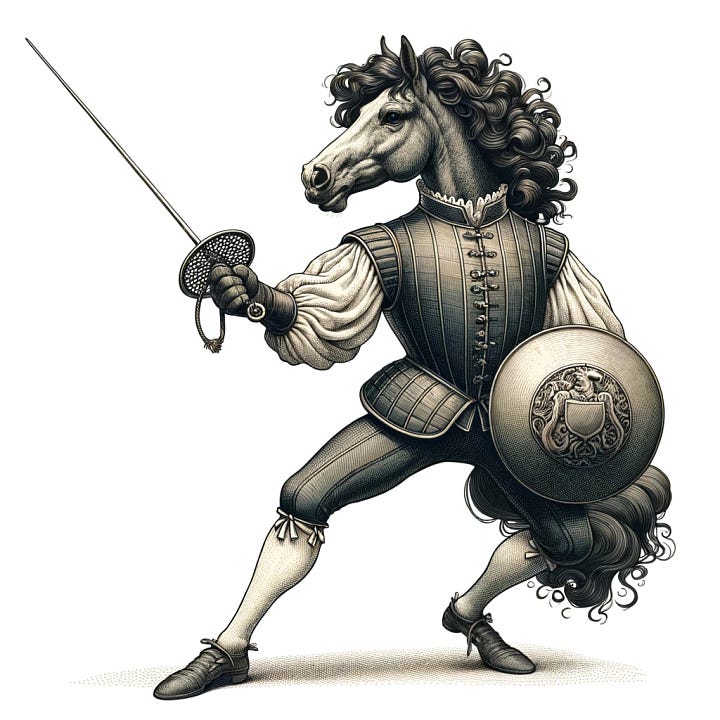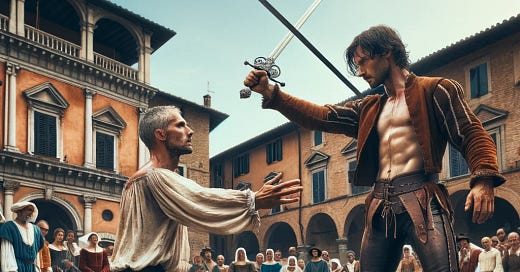Up Shit Creek Without a Sword
What Do You Do When You Drop Your Weapon in the Middle of a Duel?
The Ultimate ‘Oh Shit’ Parry
What do you when you drop your sword during a duel? You could surrender, of course. And then live with shame and infamy.
Or you could do like Guglielmo Romano. You can keep fighting, and try to take hold of your opponent’s sword. Francesco Altoni describes this duel with some detail in his Monomachia:
‘Now it is true that in a moment of desperation the brave must take this action [of grabbing the sword]. Such was the choice faced by Guglielmo Romano, who being the first to lose his sword, and being some distance from it, resolved to take the sword of his enemy. Having his dagger in his left hand, he parried a blow by the enemy, drawing out the enemy’s sword. Being very nimble, he immediately put his right hand over the enemy’s sword and grabbed it. But as he was unable to bear it, he let go of the sword and drew back.’
‘Then he switched the dagger from his left hand to his right. With this dagger he then parried another blow by the enemy, and with his dagger still in his right hand, he grabbed the opponent’s sword, the dagger and hand working together, the two of them together resisting the harm caused by the enemy’s edge.’
‘Now throwing himself quickly at the enemy’s right hand he grabbed it with his left hand. Then he twisted the enemy’s hand and arm, forcing his enemy to let go of his weapon. Finding himself a bit behind his enemy, he put the dagger back into his left hand and gripped the sword with his right hand. He then went to attack his enemy, and would have avenged the first injury by killing or capturing him, if his enemy had not done him the further injury of withdrawing away.’
‘He admitted that he did not even realize that Guglielmo had taken his sword from him. By this, it was generally understood that fear had so sapped his judgment that Guglielmo was able to completely surprise him.’
‘This reversal worked for Guglielmo because he was quick and driven to it by desperation, but for others and in other situations, the situation would not have gone so fortuitously.’


Sword and Dagger vs. Sword and Buckler:
In our last post, “Kick ‘Em in the Balls, and Hit ‘Em in the Head,” we looked at fencing for pleasure and training with the sword and buckler. In the early 1500’s, the buckler was the preferred sidearm for the one-handed sword.
Yet by the mid-1500’s the dagger had become the preferred secondary.1 Why did the dagger replace the buckler?
The dagger had a few important advantages over the buckler:
The dagger was lighter than the buckler and less tiring to use.
The dagger was deadly when used as a weapon while the buckler was not.
The dagger threatened an opponent who wanted to come into grapple.
The dagger could be easily concealed.
On the other hand all these advantages had always been true. And yet, for centuries, the buckler had been preferred over the dagger as an accompaniment to the one-handed sword.
So what changed during the middle of the 1500s?
Francesco Altoni gives us an answer:
‘The buckler is another defensive arm which was very commonly used in the past, and is still popular in Sicily, and in some parts of Gascony, and in some parts of Spain, especially around Barcelona and Valencia. Being well-esteemed in Valencia they make particularly beautiful ones. In Italy they have gone out of fashion for they began to be used by disreputable men. As a result laws sprang up against their use almost throughout all of Italy.’
While laws were similarly enacted against carrying daggers in some Italian cities, a bravo could easily tuck a dagger into the folds of hisclothes, but he could not so easily hide a buckler.
Thus of all the advantages the dagger had over the buckler, the key one was its concealability.
“Is That a Dagger in Your Pocket or Are You Just Happy To See Me?”
According to Francesco Altoni, virtually everyone in his day went around with a sword and dagger. For this reason, he accords great importance to the use of the dagger in his Monomachia. The dagger he envisages is small, about one-third of the length of a sword.
Altoni describes a variety of pugnale or daggers then current in Italy.:
Dagger
German Dagger
Small Dagger
Scimitar
Trafiere
Papagorgia
Stilleto, and so on.
One pugnale he does not describe using is the ‘Pugnale Veterino’ that Florio mentions in his dictionary. This is a dagger made of glass that is, well…
Researching history at the human level always turns up new and interesting twists about life in the past!
Altoni’s chapter on the use of the Sword and Dagger is available HERE for paid subscribers.
The dagger likely replaced the sword both in earnest fighting, and in pleasure fencing. Florio’s Dictionary describes using the dagger when playing with the foil.






